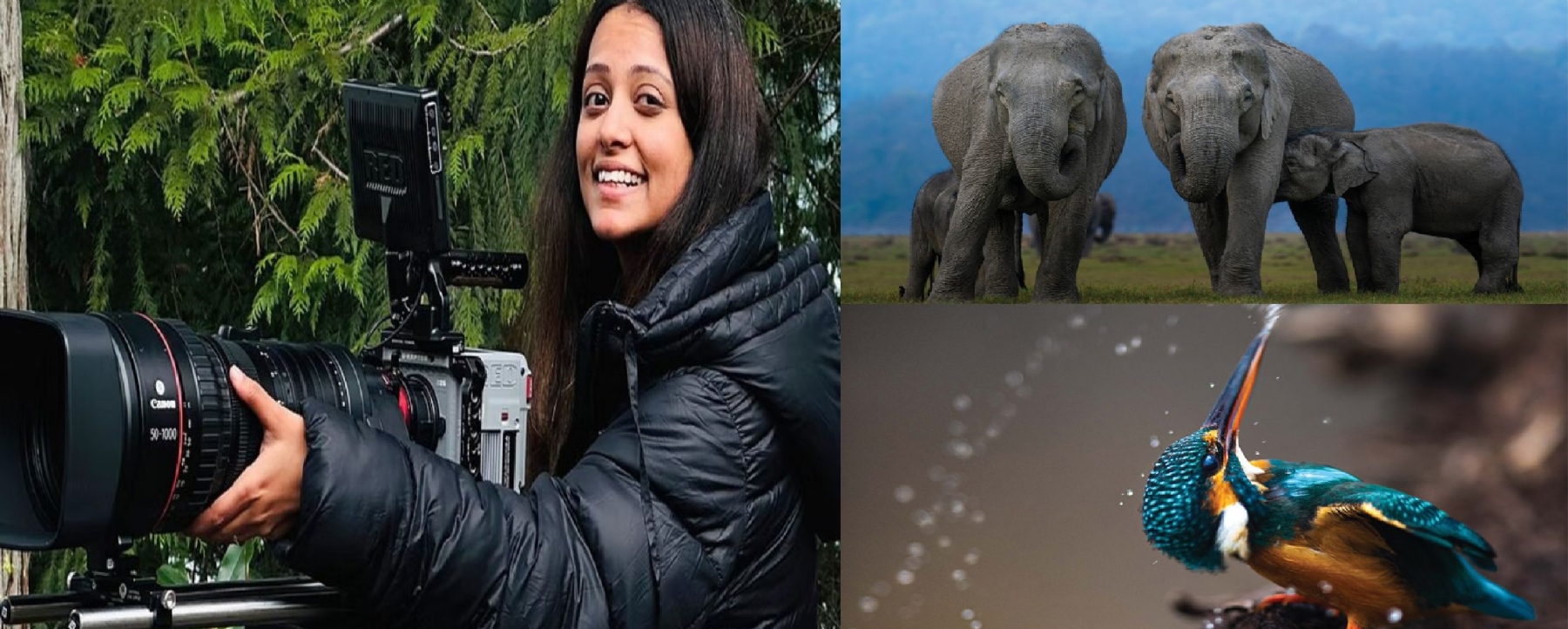Meet the women using cameras to protect wildlife
| Date :18-Apr-2025 |

■ By Krystelle DSouza :
Deep in the Himalayas, filmmaker Neha Dixit set out to track a ‘ghost’ - the elusive musk deer. She’s one of several women using their cameras to spotlight India’s disappearing wildlife. From rare birds to big cats, their films are making waves in conservation. But what have they uncovered?
IN 2021, filmmaker Neha Dixit from Nainital,Uttarakhand,setoutonatrail to the snow-clad Himalayas to track down a ‘ghost’ - a moniker given to the elusivemuskdeer.Thelocalshaveamore forgiving name for it - ‘Kasturi’. Neha wanted to film the story from a lens that tapped into the animal’s ecologicalrole beyond the allure of its musk (sourced from a pouch in its abdomen). And she succeeded. In Search of Kasturi tells a visceral and confronting story of this 25 million-year-old species (according to fossil records). The musk deer is camera-shy. So, when it finally decides to make a cameo, I celebrate. Neha has finally found Kasturi. “These are exactly the kind of stories we want to tell,” points out filmmaker Samreen Farooqui, Creative Head of Videos at Roundglass Sustain - a digital encyclopedia dedicated to India’s biodiversity.
The initiative-backed films go beyond sparking wanderlust, they also drive impact. “The world is changing fast.We see storytelling and filmmaking as engaging the audience about what needstobesaved.That responsibilitylies with a filmmaker.Because what they are essentially doing is chronic lingour Earth for generations to come.” Thatbeingsaid,Samreenaddsthatthe essence of a film is amplified when the story is embedded in the environment of the filmmaker. Because they bring a unique and personal lens to the story. RoundglassSustain,shepointsout,issimplyvisibilisingthesepowerfulnarratives. As impact storytellers, the team at Roundglass Sustain partners and collaborates with women who are scientists andresearchers,writers,journalists,filmmakers, photographers, and illustrators, and provides them with a platform to amplifytheirnarrativesandtelltheirstoriesintheirvoice.Overthepastfiveyears, Roundglass Sustain has partnered with more than 200 women creators. In Search of Kasturi: Capturing the story of the musk deer Neha’s feet ached as she crouched behind a snow-covered bush in the Himalayanhighlands,awaitingthemusk deer. But, neither the sub-zero temperatures nor the treacherous terrain could deter her. She was there with a rock-solid mission. She wanted to capture the musk deer on camera.
“We went in aware that even people who’ve lived there for decades have not seen the animal. It being crepuscular (activeintwilight) means alimitednumber of hours in which it can be spotted. And, the trickiest part of the filming process was this short window of time. We were hyper-focused, trying to spot any signs of movement.” Bugun and a Forest of Hope: Saving the Bugun Liocichla The communities in Singchung, Arunachal Pradesh stir with excitement every time a certain babbler with olivegrey plumage and a black cap flies past them. They haven’t gotten over the fact that the Bugun Liocichla (Liocichla bugunorum) is only found here and nowhere else in the world.
The bird was identified by Dr Ramana Athreya, an astronomer and ecologist from Pune, in 1996.Hescientificallydocumentedthem as a new species in 2006. NowfilmmakerShaleenaPhinya’sdocumentary is shining the spotlight on the species. Her foray into wildlife filmmaking marks a first for her Bugun community;Shaleenaisalsopartofthe10-member forest patrolling team in Singchung Bugun Village Community Reserve (SBVCR). Catapults to Cameras: Tackling illegal hunting through storytelling Everyyearthousandsofprotectedanimals -thinkjunglecats,Indianflyingfoxesandgreatercoucals,elongatedtortoises and long-billed vultures - are massacred aspartofanillegalritualistichuntinWest Bengal. Bows, catapults and spears are used for the deed.Many of these species are at risk of extinction; the hunt is the final blow to their numbers. Now, award-winning natural history and conservation filmmaker Ashwika Kapur from Kolkata, is attempting to change this reality.
She is currently a Director with the BBC Natural History unit. Her documentary, which also won the award for Best Inspirational Film at the NewYork International Film Awards 2024,doesn’tonlyshedlightontheproblem, but also possible solutions. She explains, “Through wildlife photography, we forever transformed the mindsets of children from hunting communities.They now see wild animals not as prey, but as creatures of beauty to be cherished and protected.” The filmmaking process, she says, didn’tjust save wildlife, it changed these children’s lives. “It showed them a new way to connect with the natural world around them.” Samreen shares that Roundglass Sustain is also working with the youth in these communities and through their workshops, encouraging them to stand in solidarity with their native wildlife.
Wings of Hope: A bustling village and their bird friends “Menarisproofthatconservationdoesn’t always have to come from big organisations or governments. Real change can start with a community that decides to take care of its backyard,” saysGunjan Menon about the Rajasthan village that she featured in her documentary Wings ofHope:ABustlingVillage and TheirBird Friends. Her films have won over 32 International awards and nominations across13countriesfortheirpowerfulnarratives which touch upon conservation andhuman-wildlifecoexistence.Abeliever that impact following a film shouldn’t be didactic, but spark real change on the ground, Gunjan says Menar is a perfect example. The village has become a mecca for thousands of resident and migratory birds. “The Menarias have completelytakenownershipoftheirwetlands. They welcome the birds like honoured guests and protect them fiercely. The way they talk about the birds, you can tell they see them as part of their identity. They actively patrol the area to prevent illegal hunting”, says Gunjan.
